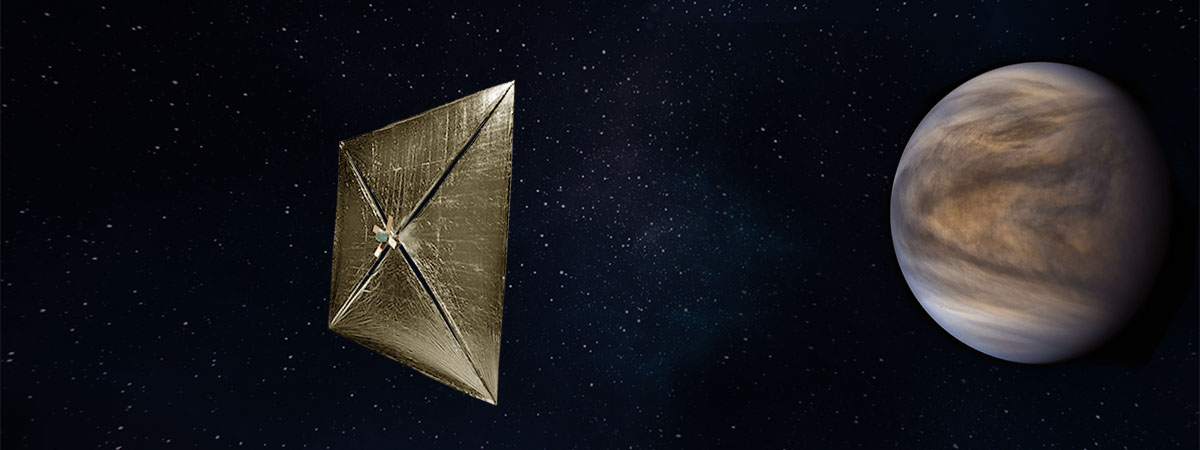IKAROS (Interplanetary Kite-craft Accelerated by Radiation of the Sun) was a demonstrator satellite designed by JAXA (Japanese Aerospace Exploration Agency) to demonstrate the latest solar sail propulsion techniques. The mission began in 2010, and headed to the planet Venus to test the new solar sail concept. The solar sail provided both propulsive power as well as electrical power to the equipment.
IKAROS’s main objectives were: the deployment of a large solar sail (200 m2); the generation of power through solar cells located in the sail’s membrane; the demonstration of the viability of the photon propulsion technique; and the demonstration of GNC (guidance, navigation and control) techniques, which direct the small but constant accelerations caused by this type of system.
The IKAROS probe was the first spacecraft to demonstrate the viability of solar sail propulsion and power generation.
The concept of a solar sail is similar to that of a ship’s sail, except that instead of generating momentum by harnessing the kinetic energy of wind on fabric, it uses the collision of photons emitted by the Sun on a reflective membrane. Accordingly, the more photons the sail membrane is able to reflect, the more thrust the aircraft will receive. Because this thrust is very small, the membrane has to be very large in order to propel a spacecraft. This technology allows a spacecraft system to move without consuming fuel, as long as it is able to generate sufficient power and can orient the sail in the right direction to follow a predetermined trajectory.
The theory behind this idea was actually described several decades ago. However, it met with multiple technical obstacles, such as what materials to use, how to deploy the membrane, or its attitude control system. To solve some of these problems on the IKAROS mission, JAXA designed a square-shaped solar sail with no rigid support structure, which was attached to the satellite body by ropes. To deploy the sail, they used the centrifugal force generated by four masses (2 kg in total) attached to every tip of the membrane. Once the deployment phase was completed, this force was maintained in order to preserve the shape of the sail. Attitude control was therefore one of the mission’s most critical systems. Traditional means of propulsion (chemical propellants) would induce oscillations of the sail relative to the central body, and photon control was also complex, as the membrane did not remain rigid in the face of solar pressure forces.
The membrane, which weighed around 14 kg, consisted of four trapezoidal sections. It contained solar cells that were capable of generating up to 500 W of power, which occupied just 5% of the membrane surface. It also had a dust detection system and reflectivity control equipment. The rest of the membrane surface consisted of a polyimide layer (7.5 µm thick) covered by an evaporated aluminium layer (80 nm thick). The polyimide layer gave the sail high thermal, chemical and mechanical resistance, and also ensured it remained very light. The aluminium layer reflected maximum amounts of light in order to achieve thrust.
The IKAROS probe had a total mass of 308 kg and consisted of a cylindrical body with a 1.6 m diameter and a height of 0.9 m. It was launched on 20th May 2010 from the Tanegashima Space Center, one of Japan’s space research and development facilities. The membrane deployment was completed on 10th June of that same year, and on 23rd July they verified that the attitude control system was working perfectly, and that the satellite was being propelled by solar wind. Seven months later, in December 2010, JAXA successfully completed the IKAROS experiments, and it went into hibernation mode. However, they decided that the mission would not end there. In August 2013, the satellite was still gaining speed (+400 m/s) from the solar sail. On 23rd April 2015, almost 5 years after its initial mission, IKAROS woke up for the fourth and last time, transmitting its final data, which would be crucial for improving the design of the solar sail space navigation model. On 21st May of that same year, JAXA was unable to establish communications, and the mission was terminated.
To this day, IKAROS has been the only spacecraft capable of generating the propulsive power to travel between two planets by means of a solar sail. The success of IKAROS therefore lies not only in the speed achieved by the satellite or the promising results obtained, but also in the number of possible lines of research that may arise from this mission, and the potential future missions that will attempt to make advances in the field of fuel-free space propulsion.
JAXA, the Japanese Exploration Aerospace Agency, is currently at the forefront of spacecraft solar sailing. JAXA was established on 1st October 2003, as a result of the union of three Japanese aerospace organisations: ISAS (Institute of Space and Astronautical Science), NAL (National Aerospace Laboratory of Japan) and NASDA (National Space Development Agency of Japan). It was created as a central agency to support the development of the country’s entire aerospace industry.
JAXA has managed to take eight Japanese astronauts into space and has participated in various international programmes, including the ISS (International Space Station), where it developed the Japanese Experiment Module, nicknamed the Kibo laboratory. It is currently involved in collaborative space exploration programmes such as the Gateway programme, which has the objective of placing a space station continuously inhabited by humans into lunar orbit; the SLIM (Smart Lander for Investigating Moon) programme, which aims to demonstrate a high-precision landing system; and the MMX (Martian Moon Exploration) programme, which will bring the very first samples from Phobos (Mars’s largest moon) back to Earth.



